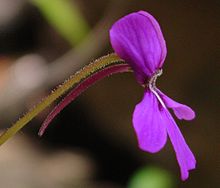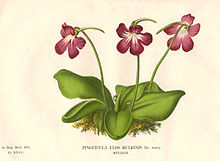
Genlisea is a genus of carnivorous plants also known as corkscrew plants. The 30 or so species grow in wet terrestrial to semi-aquatic environments distributed throughout Africa and Central and South America. The plants use highly modified underground leaves to attract, trap and digest minute microfauna, particularly protozoans. Although suggested a century earlier by Charles Darwin, carnivory in the genus was not proven until 1998.

Pinguicula laxifolia is an insectivorous plant of the genus Pinguicula native to the Mexican state of Tamaulipas, the only member of the section Orchidioides. Its pendulous leaves are unusual in the genus, which features mostly species with stiff or succulent leaves.

Pinguicula gypsicola is an insectivorous plant of the genus Pinguicula native to the Mexican state of San Luis Potosi, a heterophyllous member of the section Orcheosanthus. It grows in gypsum soils and forms stemless rosettes of upright, narrow leaves.

Pinguicula alpina, also known as the alpine butterwort, is a species of carnivorous plant native to high latitudes and altitudes throughout Eurasia. It is one of the most widespread Pinguicula species, being found in mountainous regions from Iceland to the Himalayas. Native to cold climates, it is a temperate species, forming prostrate rosettes of green to red leaves and white flowers in the summer and a tight hibernaculum during a period of winter dormancy in the winter. Like all members of the genus, P. alpina uses mucilaginous glands covering the surface of its summer leaves to attract, trap, and digest arthropod prey.

Pinguicula primuliflora, commonly known as the southern butterwort or primrose butterwort, is a species of carnivorous plant belonging to the genus Pinguicula. It is native to the southeastern United States. The typical variety forms a white flower in blooming. Like other butterworts, it has sticky adhesive leaves which attract, capture and digest arthropod prey in order to supply the plant with nutrients such as nitrogen not found in the nutrient poor, acidic soil that it grows in. Its name derives from the fact it is usually the first one to flower in the spring.

Pinguicula gigantea is a tropical species of carnivorous plant in the family Lentibulariaceae. Its native range is within Mexico. P. gigantea's flower is usually a purple colour with the occasional light blue also seen. P. gigantea was once classified as Pinguicula ayautla.

Pinguicula conzattii is an insectivorous plant of the genus Pinguicula native to the Mexican state of Oaxaca, a member of the section Heterophyllum. Closely related to Pinguicula mirandae, it is notable for being pubescent on both sides of its winter leaves. It is named in honour of Cassiano Conzatti, an Italian-born botanist who spent most of his life in Mexico.

Pinguicula acuminata is an insectivorous plant of the genus Pinguicula endemic to the Mexican state of Hidalgo, a member of the section Heterophyllum. It is notable for producing flowers while the winter rosette is buried beneath the soil surface. Described in 1839, it was not rediscovered until 150 years later.

Pinguicula vulgaris, the common butterwort, is a perennial carnivorous plant in the bladderwort family, Lentibulariaceae.

Carnivorous plants are plants that derive some or most of their nutrients from trapping and consuming animals or protozoans, typically insects and other arthropods, and occasionally small mammals and birds. They still generate all of their energy from photosynthesis. They have adapted to grow in waterlogged sunny places where the soil is thin or poor in nutrients, especially nitrogen, such as acidic bogs. They can be found on all continents except Antarctica, as well as many Pacific islands. In 1875, Charles Darwin published Insectivorous Plants, the first treatise to recognize the significance of carnivory in plants, describing years of painstaking research.

Pinguicula orchidioides is a perennial rosette-forming insectivorous herb native to Mexico and Guatemala. A species of butterwort, it forms summer rosettes of flat, succulent leaves up to 5 centimeters (2 in) long, which are covered in mucilaginous (sticky) glands that attract, trap, and digest arthropod prey. Nutrients derived from the prey are used to supplement the nutrient-poor substrate that the plant grows in. Uniquely among Pinguicula species from the Americas, p. orchidioides produces gemma-like basal buds which elongate into stolons and serve as a means of asexual reproduction. In the winter the plant forms a non-carnivorous rosette of small, fleshy leaves that conserves energy while food and moisture supplies are low. Single purple flowers appear between July and September on upright stalks up to 22 centimeters long.

Pinguicula elizabethiae is a perennial rosette-forming insectivorous herb native to the Mexican states of Querétaro and Hidalgo. A species of butterwort, it forms summer rosettes of flat, succulent leaves up to 5 centimeters (4 in) long, which are covered in mucilaginous (sticky) glands that attract, trap, and digest arthropod prey. Nutrients derived from the prey are used to supplement the nutrient-poor substrate that the plant grows in. In the winter the plant forms a non-carnivorous rosette of small, fleshy leaves that conserves energy while food and moisture supplies are low. Single purple flowers appear between July and October on upright stalks up to 75 millimeters long.

Pinguicula, commonly known as butterworts, is a genus of carnivorous flowering plants in the family Lentibulariaceae. They use sticky, glandular leaves to lure, trap, and digest insects in order to supplement the poor mineral nutrition they obtain from the environment. Of the roughly 80 currently known species, 13 are native to Europe, 9 to North America, and some to northern Asia. The largest number of species is in South and Central America.
Utricularia uxoris is a small epiphytic carnivorous plant in the genus Utricularia that is endemic to Costa Rica. It is distinguished from all other members of section Orchidioides in having green glabrous flowers with a white spur and its small size. The species is only known from its type locality in Reserva Biológica El Copal, Cartago Province. It was collected in 2004 by Jorge Gómez-Laurito, Diego Salazar, and Jorge Carmona and then formally described in 2005 by Gómez-Laurito (2005).

Pinguicula ionantha is a rare species of flowering plant in the butterwort family known by the common names Godfrey's butterwort and violet butterwort. It is endemic to the US state of Florida, where it only occurs in the central Florida Panhandle. It is threatened by the loss of its habitat, and it is a federally listed threatened species of the United States.

Pinguicula lutea, commonly known as the yellow butterwort, is a species of warm-temperate carnivorous plant in the family Lentibulariaceae. It grows in savannas and sandy bog areas of the Southeastern United States.

Pinguicula filifolia, is a carnivorous species of plant found predominantly in western Cuba and some of the neighboring regions. It was discovered by Charles Wright in 1866. It is a tropical plant that uses sticky secretions on its leaves to catch small insects, pollen, and other plant debris to help supplement its own nutrition. It thrives in swamp like white sand savannahs with high temperatures and humidity.

Pinguicula macroceras, the California butterwort or horned butterwort, is a species of perennial carnivorous herb that is native to the North American Pacific coast, as well as other select distributions in Canada, Russia, Japan, and the United States.[3] [7] Common names include California butterwort, horned butterwort and butterwort. Pinguicula macroceras belongs to the genus Pinguicula and the family Lentibulariaceae.
Pinguicula hemiepiphytica is a tropical carnivorous plant species native to the cloud forests of Oaxaca, Mexico. It was first identified in 1991 and is one of the few epiphytic species in the genus.




























